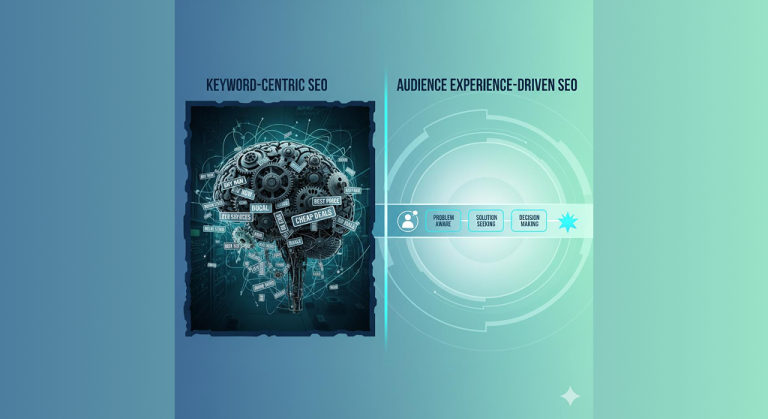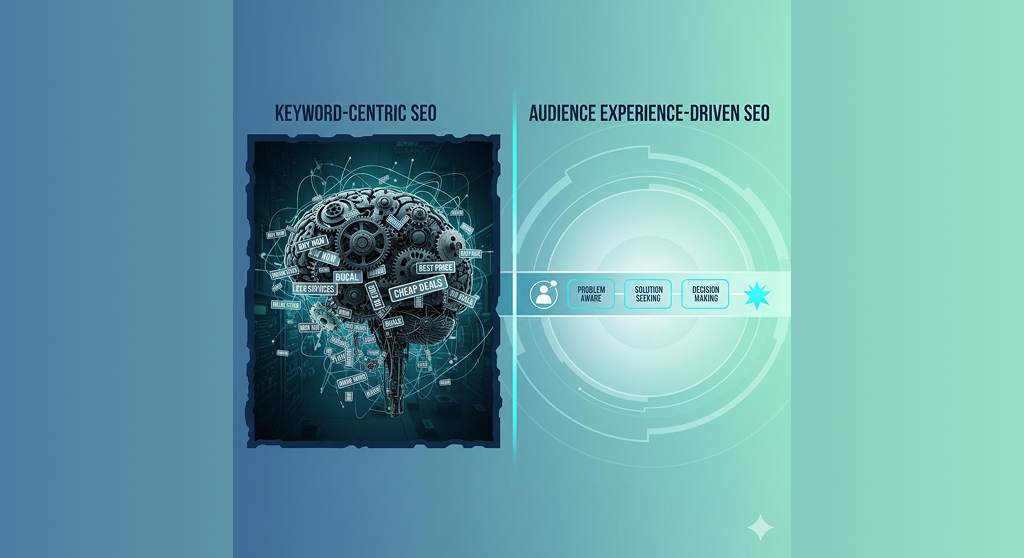The old search engine optimisation playbook is obsolete. For years, small businesses were told to win at SEO by targeting keywords, building backlinks, and appeasing a mysterious, ever-changing algorithm. This created a generation of websites packed with robotic content designed to be read by search crawlers, not actual customers. That era is over.

Forget keywords.
Your SEO strategy needs an audience experience overhaul.
Google is no longer a simple search engine; it is a sophisticated answer engine. Its primary objective is not to rank pages based on keyword density but to satisfy user intent with the most helpful, efficient, and trustworthy experience possible. Chasing algorithm updates is a reactive, defensive game. Designing for your audience is a proactive, offensive strategy that builds a durable competitive advantage.
This is the shift to an audience experience-driven SEO strategy. It is the disciplined practice of aligning your website’s content, structure, and technical performance with the explicit and implicit needs of your target user. It reframes SEO not as a marketing checklist, but as a core component of your digital product and customer service. The algorithm’s ranking is simply the outcome of a superior user experience, not the objective itself.
The fundamental shift: from algorithm hacking to human-centric search
To understand why this change is necessary, you must understand Google’s business model. Google succeeds when users find what they are looking for quickly and effectively, reinforcing its position as the default gateway to the internet. Every major update—from Panda and Penguin to the recent helpful content and page experience updates—has been a step toward better emulating human judgment of quality and usefulness.
An audience experience-driven strategy accepts this reality. It operates on a simple premise: if you provide the best answer and the best experience for a person asking a question, Google’s algorithm will, over time, have no choice but to recognise and reward you.
This approach integrates three distinct disciplines into a single, cohesive strategy:
User Experience (UX) Design: The practice of making a website intuitive, accessible, and enjoyable to use.
Content Strategy: The planning, creation, and governance of content that is useful, usable, and aligned with business goals.
Technical SEO: The process of optimising a website’s infrastructure so that search engines can crawl and index it effectively.
In an audience-first model, these are not separate functions. A slow-loading page (a technical SEO problem) creates a poor user experience. Confusing content (a content strategy problem) frustrates the user and sends negative signals to search engines. The disciplines are inseparable.
The three pillars of an audience experience seo strategy
Transitioning your mindset is the first step. Executing the strategy requires focusing on three core pillars that connect what your audience wants with how your website delivers it.
Pillar 1: Intent mapping over keyword stuffing
Keywords are not the starting point; they are the evidence. They are the language people use to articulate a deeper need or “intent.” The old method was to find a high-volume keyword and write an article about it. The new method is to identify a user’s core problem and create the best possible resource to solve it. The relevant keywords will naturally appear in that resource.
User intent generally falls into four categories:
Informational: The user wants to know something. (e.g., “how to fix a leaky faucet”)
Navigational: The user wants to go to a specific website. (e.g., “youtube”)
Commercial: The user is investigating products or services to buy. (e.g., “best tankless water heaters”)
Transactional: The user wants to complete an action. (e.g., “buy honeywell thermostat”)
A small business must map its content directly to these intents. Consider a local plumbing company. A strategy based on keyword stuffing might try to cram “plumber in [city]” onto every page. An intent-based strategy recognises two very different user journeys:
The Emergency: A user with a burst pipe has an urgent, transactional intent. Their search might be “emergency plumber near me.” They do not need a 2,000-word blog post on the history of plumbing. They need a mobile-friendly page that loads in under a second, with a click-to-call phone number placed prominently at the top. The user experience is the solution.
The Remodel: A user planning a bathroom renovation has a commercial and informational intent. Their search might be “cost to install a new shower.” They need detailed blog posts, project galleries, and maybe a cost-calculator tool. A long, in-depth guide is the perfect experience for this user.
Your action plan: Stop using keyword research tools as a content instruction manual. Instead, use them as an audience intelligence platform. Look at the “People Also Ask” sections in Google search results. Analyse the search queries in your Google Search Console report. These are your customers telling you exactly what they want to know. Map every important page on your site to a specific user intent. If a page doesn’t serve a clear intent, it’s either dead weight or needs to be completely re-engineered.
Pillar 2: Content as a service, not just an asset
Your content should not just exist; it must do something for the user. It should solve a problem, answer a question, or complete a task more efficiently than your competitor’s content. Think of your content not as static text but as an interactive service.
This means moving beyond the standard blog post. While articles have their place for informational intent, superior user experience often comes from more dynamic formats:
Calculators: A mortgage broker offers a repayment calculator.
Checklists: A moving company provides an interactive “moving day checklist.”
Configurators: An e-commerce site selling custom PCs allows users to build and price their machine in real-time.
Templates: A marketing agency offers free Google Data Studio report templates.
These content formats deliver immense value. They keep users on your site longer (increasing dwell time), encourage repeat visits, and generate valuable backlinks from other sites that find them useful. These are all powerful positive signals for SEO.
A study by Backlinko found that more interactive and visual “content formats are critical for generating links.” Tools, in particular, are highly effective because they provide a utility that is difficult to replicate. For a small business, creating one truly useful tool can be more valuable for SEO than writing 50 mediocre blog posts.
Your action plan: Conduct a content utility audit. Review your top 10 most-visited pages. For each page, ask: “What job does this content do for the user?” Does it just inform, or does it enable? Identify one core process in your business that could be turned into a simple online tool or interactive resource. It doesn’t need to be complex. A simple spreadsheet converted into a web-based calculator can become a magnet for traffic and links.
Pillar 3: Technical performance as a user experience feature
Technical SEO is no longer about XML sitemaps and robots.txt files alone. It is about speed, mobile usability, and security. These are not abstract technical concepts; they are fundamental features of the user experience. A slow website is disrespectful of your user’s time. A website that is broken on mobile is telling a massive segment of your audience that you do not care about their business.
Google quantifies this experience with its Core Web Vitals (CWV):
Largest Contentful Paint (LCP): How long does it take for the main content of a page to load? This measures loading performance.
Interaction to Next Paint (INP): How quickly does a page respond when a user clicks, taps, or types? This measures responsiveness. (Note: INP replaced First Input Delay (FID) in March 2024).
Cumulative Layout Shift (CLS): How much do elements on the page move around unexpectedly as it loads? This measures visual stability.
These are not arbitrary metrics. They are direct proxies for user frustration. A page that loads slowly, is unresponsive, or has elements that jump around as you try to click them provides a bad experience. Data consistently proves this impacts business outcomes. A Portent study found that a site that loads in 1 second has a conversion rate 3x higher than a site that loads in 5 seconds.
Your action plan: Go to Google’s PageSpeed Insights and test your most important pages. Do not fixate on the overall score. Instead, scroll down to the “Opportunities” and “Diagnostics” sections. These reports give you a specific, prioritised list of actions to take, such as “reduce unused JavaScript” or “properly size images.” For a small business, focusing on image optimisation and leveraging browser caching are often the highest-impact, lowest-effort starting points. Treat the performance report not as a technical audit, but as a customer-service report card.

A practical implementation roadmap for small businesses
Shifting to an audience experience-driven strategy is a process, not a one-time project. Here is a step-by-step roadmap to get started.
Redefine your analytics. Stop obsessing over vanity metrics like sessions and pageviews. Reconfigure your analytics to measure experience. Key metrics now include:
Scroll depth: Are users actually reading your content?
Dwell time/Average engagement time: How long are they spending on the page?
Conversion rate per page: Which pages are effectively driving business goals?
Bounce rate/low engagement rate: Which pages are causing users to leave immediately?
Listen to your audience’s digital body language. You do not need expensive focus groups. The data is already there.
Analyse Google Search Console queries: What exact phrases are people using to find you? This is a direct transcript of their needs.
Review contact form submissions and customer service emails: What questions are asked repeatedly? This is a goldmine for content ideas that serve a real, demonstrated need.
Install a free heat-mapping tool like Microsoft Clarity: Watch real user sessions. See where they click, where they get stuck, and where they abandon your site. This is the most brutally honest feedback you will ever receive.
Conduct a journey-based content audit. Create a simple spreadsheet. List your key pages. For each page, identify the target audience, the user intent it serves (informational, commercial, etc.), and what stage of the customer journey it addresses (awareness, consideration, decision). This process will immediately reveal the major gaps and redundancies in your content. You will find you have ten blog posts for the “awareness” stage but no content at all to help users make a “decision.”
Prioritise technical fixes that hurt the experience most. Do not try to fix everything at once. Use PageSpeed Insights to find the pages with the worst Core Web Vitals scores that also receive significant traffic. Start there. Fixing the speed of your most popular product page is far more impactful than optimising a blog post from five years ago that nobody reads.
The future of search visibility belongs to businesses that obsess over their customers, not over algorithms. By mapping intent, creating content that serves, and ensuring your website is technically excellent, you are not just “doing SEO.” You are building a better business. The algorithm is designed to find and reward that effort. Stop chasing it and start leading it.

